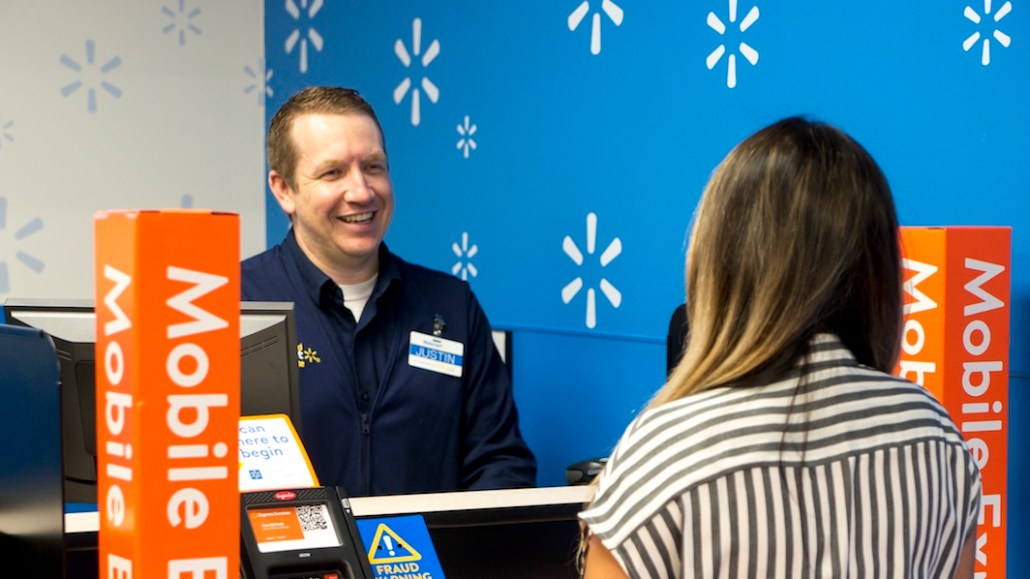
Walmart is using money services to lock in customers, grow sales, and stave off e-commerce rivals.
The retailer offers its customers menu of money services that includes on-site check cashing, bill payments, money-transfer services and prepaid cards. It announced last week that its MoneyCard platform — a prepaid card and budgeting tool accessible through an app and a website — saved its customers $2 billion since its inception two years ago.
Walmart wants to offer money services to customers who may rely less on traditional financial services companies like banks, and may not qualify for high-earning cash-back credit cards (MoneyCard offers 3 percent cash back on online purchases, 2 percent at Murphy USA and Walmart fuel stations, and 1 percent cash back in stores). It lowers barriers to banking to underbanked customers, and competes with other retailers looking to grab a piece of this market. It also competes with payday-advance companies by letting customers who set up direct deposit access their pay checks up to two days early.
Walmart wouldn’t comment on whether it’s resulted in a sales lift; a company spokesperson said the services are being offered to add convenience. Steven Streit, CEO of Green Dot, the financial services company that’s partnering with Walmart on MoneyCard, told investors in a February earnings call that Walmart owns the commission from the use of the MoneyCards and has increased sales in stores and online.
The MoneyCard savings milestone marks Walmart’s slow march to drive customers to its ecosystem through financial services tools. The company recently launched a purchase financing option through startup Affirm in late February. Money services help Walmart position itself as a full-service retail and financial center for its customers — a tool to encourage customers to come to stores and make more purchases at Walmart.
This is especially important as its closest e-commerce rival, Amazon, aims for lower-income and underbanked customers through discount programs and prepaid cards that are reloadable at physical retail locations.
Walmart currently offers three types of financial products: its in-store money centers operate as quasi-banks, offering on-site services to grow in-store traffic. These include check printing, check cashing, international money-transfer services, money orders, tax preparation services, and bill-payment services. It offers prepaid debit cards that include cash back and savings “vaults” reminiscent of online banking tools, along with credit cards and point-of-sale financing through Affirm.
Through money services, Walmart isn’t quite aiming to take on banks, but it’s encouraging lower-income and underbanked customers to save through digital savings tools and cash-back offers, and ultimately direct that spending toward Walmart purchases.
“The idea of being able to go to one place to get everything done — whether digitally or physically — is the strategy they’re working on,” said Aite Group senior analyst Kevin Morrison.
Amazon has slowly moved into Walmart’s turf through a prepaid card (Amazon Cash) launched two years ago that can be topped up at retail locations and reports it’s opening grocery stores aimed at lower-income customers. Amazon Cash lets customers top up their Amazon balances at more than 30,000 participating retail stores, including popular chains like CVS, Gamestop and 7-Eleven. While money services are a means to keep underbanked customers inside Walmart’s ecosystem and ultimately spend their dollars there, it’s also a broader branding play, argues Jonathan Smalley, CEO of data analytics company Yaguara.
“It’s helpful as opposed to predatory — in the context of the Walmart versus Amazon race, it’s a huge opportunity for Walmart to say ‘look we’re not just trying to increase our bottom line, and we genuinely care about our customers,'” he said.
The challenge, however, will be to continue to keep customers’ interest, particularly as other retailers grow their loyalty programs and financial products for customers.
“Walmart is feeling they have to do something in this area, and the challenge is making sure the product offerings are relevant — for a lot of consumers they’re not, and they don’t want loads of cards,” said Neil Saunders, managing director of GlobalData Retail.
Subscribe to the Digiday Retail Briefing: An email with news, quotes and stats covering the modernization of retail and e-commerce, delivered three times per week.
More in Marketing

Zero-click search is changing how small brands show up online — and spend
To appease the AI powers that be, brands are prioritizing things like blogs, brand content and landing pages.

More creators, less money: Creator economy expansion leaves mid-tier creators behind
As brands get pickier and budgets tighten, mid-tier creators are finding fewer deals in the booming influencer economy.

‘Still not a top tier ad platform’: Advertisers on Linda Yaccarino’s departure as CEO of X
Linda Yaccarino — the CEO who was never really in charge.





